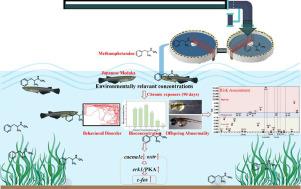Water Research ( IF 12.8 ) Pub Date : 2020-07-10 , DOI: 10.1016/j.watres.2020.116164 Zhenglu Wang 1 , Kang Mao 2 , Wei Du 3 , Min Cai 4 , Zhaobin Zhang 5 , Xiqing Li 5

|
Methamphetamine (METH) has been recognized as an emerging organic contaminant as it was widely detected in the aquatic environment via wastewater effluent discharge. However, the ecological hazard posed by METH at environmentally relevant concentrations was remained unclear. In this study, adult medaka fish were exposed to METH at environmental levels (0.05, 0.2, 0.5, 5 μg L−1) and high level (25 and 100 μg L−1) for 90 days to investigate its effect on ecologically behavioral functions, histopathology, bioconcentration, and transgenerational toxicity. The significant increase of locomotion activity, total distance, and max velocity of adult medaka were observed at low METH levels (0.2–0.5 μg L−1), while it markedly decreased at high levels (25–100 μg L−1). This effect may increase the predation risk of the fish. The significant alteration on the relative expressions of the genes (cacna1c, oxtr, erk1, and c-fos), as well as the contents of the proteins (oxytocin (OXT) and protein kinase A (PKA)) involved in Voltage Dependent Calcium Channel (VDCC) and Mitogen-Activated Protein Kinase (MAPK) signaling channel induced by METH could partly elucidate the underlying mechanisms of the changes of the behavioral traits. METH could induce obvious minimal gliosis, neuronal loss, and necrotic in brain tissues. Additionally, the significant increase of hepatic-somatic index (HSI) of male medaka at 0.2–5 μg L−1 groups, and the decrease of female medaka at 100 μg L−1 group indicated male fish was more susceptible to METH. Nephric-somatic index (NSI) of medaka markedly declined induced by METH at 0.05–100 μg L−1. The bioconcentration factor (BCF) (0.4–5.8) in medaka fish revealed the bioconcentration potential of METH in fish. This study for the first time demonstrated METH could induced the development defects of larvae in F1 generation at environmentally relevant concentrations, thereby resulting in a significant decrease in the capacity of fish to produce offspring. Meanwhile, the RQ values (>1) of METH in river in China, USA, and Australia showed a high teratogenic risk level, suggesting the ecosystem-levels consequence posed by METH should be concerned.



























 京公网安备 11010802027423号
京公网安备 11010802027423号